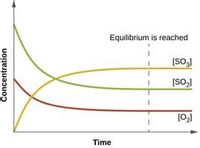
Chemistry
10th Edition
ISBN: 9781305957404
Author: Steven S. Zumdahl, Susan A. Zumdahl, Donald J. DeCoste
Publisher: Cengage Learning
expand_more
expand_more
format_list_bulleted
Question
The graph below follows the concentration of species as a
|
2 SO2 (g) + O2 (g) ⇄ 2 SO3 (g) |
||
|
2 SO3 (g) ⇄ 2 SO2 (g) + O2 (g) |
||
|
SO2 (g) + O2 (g) ⇄ SO3 (g) |
||
|
SO3 (g) ⇄ SO2 (g) + O2 (g) |
which answer?

Transcribed Image Text:Equilibrium is reached
[So,)
Time
Concentration
Expert Solution
This question has been solved!
Explore an expertly crafted, step-by-step solution for a thorough understanding of key concepts.
Step by stepSolved in 2 steps

Knowledge Booster
Learn more about
Need a deep-dive on the concept behind this application? Look no further. Learn more about this topic, chemistry and related others by exploring similar questions and additional content below.Similar questions
- What is the equilibrium constant expression for the reaction NO2(g) ⇄ N2O4(g)?arrow_forwardOne of the steps in the production of sulfuric acid involves the catalytic oxidation of sulfur dioxide. 2 SO2 (g) + O2 (g) → 2 SO3 (g) What is the equilibrium expression?arrow_forwardConsider the following chemical equilibrium: A(s) + B(g) ⇄ 3 C(s) + 4 D(g) If the initial pressure of B is 4.26 bar, the total pressure at equilibrium is 7.15 bar. Use these pressures to calculate Keq.arrow_forward
- For which of these reactions will there be no effect on the relative amounts of the substances present at equilibrium when the pressure of the system is increased at constant temperature? O 2 sO, (g) + 0,(g) = 2 SO, (g) + heat heat + CO, (g) + NO(g) =CO(g) + NO, (g) heat + 2 Cl, (g) + 2 H,O(g) = 4 HCI(g) + 0, (g) N, (g) + 3 H, (g) = 2 NH, (g) + heatarrow_forwardThe equilibrium constant for the reaction 2NO(g)+Br2(g)⇌2NOBr(g) is Kc=3.0×10−2 at a certain temperature. Calculate Kc for the following reaction: 2NOBr(g)⇌2NO(g)+Br2(g)arrow_forwardConsider the following reactions:1. P4(s) + 6 Cl2(g)⇄ 4 PCl3(g) K 1 = 2.00 × 10192. PCl5(g) ⇄ PCl3(g) + Cl2 (g) K 2 = 1.13× 10-2Calculate K for the reaction: 4 PCl5(g) ⇄ P4(g) + 10 Cl2(g)arrow_forward
- The question is attached belowarrow_forwardConsider the reaction: CH3COOH (aq) + H₂O(1) K = 1.8 x 10-5 at 25 °C Part A If a solution initially contains 0.225 mol L-¹ CH3COOH, what is the equilibrium concentration of H3O+ at 25 °C? Express your answer in moles per litre to two significant figures. 15. ΑΣΦ [H3O+] = H3O+(aq) + CH3COO (aq) Submit Request Answer ? mol L-1arrow_forwardCarbon disulfide and oxygen react to form carbon dioxide and sulfur dioxide, like this: CS₂(g) +30₂(g) CO₂(g) +2SO₂(g) Suppose a mixture of CS2, O2, CO2 and SO₂ has come to equilibrium in a closed reaction vessel. Predict what change, if any, the perturbations in the table below will cause in the composition of the mixture in the vessel. Also decide whether the equilibrium shifts to the right or left. perturbation Some O₂ is added. - Some CO₂ is removed. change in composition The pressure of CS₂ will The pressure of CO₂ will The pressure of CS₂ will The pressure of O₂ will ? ? ? ? ↑ ↑ ↑ ↑ shift in equilibrium X O OOO to the right to the left (none) to the right to the left O (none)arrow_forward
- Using thermodynamic data to calculate K Using any data you can find in the ALEKS Data resource, calculate the equilibrium constant K at 25.0 °C for the following reaction. 2 NH3(g) →>> 4 N₂H₁(g) + H2(g) Round your answer to 2 significant digits. K = П ☐ x10 ☑ 0/5 izabella ? ola 18 Ar 館arrow_forwardFor the following reactions, determine whether the forward or reverse reaction is favored. 2 SO3(g) ⇌ 2 SO2(g) + O2(g) K = 2.5 × 1025 N2(g) + O2(g) ⇌ 2 NO(g) K = 4.1 × 10-31 H2(g) + Cl2(g) ⇌ 2 HCl(g) K = 5.1 × 108arrow_forwardThe following reactions have the indicated equilibrium constants at a particular temperature: N2 (g) + O2(g) ⇌ 2NO (g) Kc = 7.1 ×10−25 2NO (g) + O2 (g) ⇌ 2NO2(g) Kc = 6.4 × 109 Determine the value of the equilibrium constant for the following equation at the same temperature: 2NO(g) ⇌ N2(g) + O2(g)arrow_forward
arrow_back_ios
arrow_forward_ios
Recommended textbooks for you
 ChemistryChemistryISBN:9781305957404Author:Steven S. Zumdahl, Susan A. Zumdahl, Donald J. DeCostePublisher:Cengage Learning
ChemistryChemistryISBN:9781305957404Author:Steven S. Zumdahl, Susan A. Zumdahl, Donald J. DeCostePublisher:Cengage Learning ChemistryChemistryISBN:9781259911156Author:Raymond Chang Dr., Jason Overby ProfessorPublisher:McGraw-Hill Education
ChemistryChemistryISBN:9781259911156Author:Raymond Chang Dr., Jason Overby ProfessorPublisher:McGraw-Hill Education Principles of Instrumental AnalysisChemistryISBN:9781305577213Author:Douglas A. Skoog, F. James Holler, Stanley R. CrouchPublisher:Cengage Learning
Principles of Instrumental AnalysisChemistryISBN:9781305577213Author:Douglas A. Skoog, F. James Holler, Stanley R. CrouchPublisher:Cengage Learning Organic ChemistryChemistryISBN:9780078021558Author:Janice Gorzynski Smith Dr.Publisher:McGraw-Hill Education
Organic ChemistryChemistryISBN:9780078021558Author:Janice Gorzynski Smith Dr.Publisher:McGraw-Hill Education Chemistry: Principles and ReactionsChemistryISBN:9781305079373Author:William L. Masterton, Cecile N. HurleyPublisher:Cengage Learning
Chemistry: Principles and ReactionsChemistryISBN:9781305079373Author:William L. Masterton, Cecile N. HurleyPublisher:Cengage Learning Elementary Principles of Chemical Processes, Bind...ChemistryISBN:9781118431221Author:Richard M. Felder, Ronald W. Rousseau, Lisa G. BullardPublisher:WILEY
Elementary Principles of Chemical Processes, Bind...ChemistryISBN:9781118431221Author:Richard M. Felder, Ronald W. Rousseau, Lisa G. BullardPublisher:WILEY

Chemistry
Chemistry
ISBN:9781305957404
Author:Steven S. Zumdahl, Susan A. Zumdahl, Donald J. DeCoste
Publisher:Cengage Learning

Chemistry
Chemistry
ISBN:9781259911156
Author:Raymond Chang Dr., Jason Overby Professor
Publisher:McGraw-Hill Education

Principles of Instrumental Analysis
Chemistry
ISBN:9781305577213
Author:Douglas A. Skoog, F. James Holler, Stanley R. Crouch
Publisher:Cengage Learning

Organic Chemistry
Chemistry
ISBN:9780078021558
Author:Janice Gorzynski Smith Dr.
Publisher:McGraw-Hill Education

Chemistry: Principles and Reactions
Chemistry
ISBN:9781305079373
Author:William L. Masterton, Cecile N. Hurley
Publisher:Cengage Learning

Elementary Principles of Chemical Processes, Bind...
Chemistry
ISBN:9781118431221
Author:Richard M. Felder, Ronald W. Rousseau, Lisa G. Bullard
Publisher:WILEY